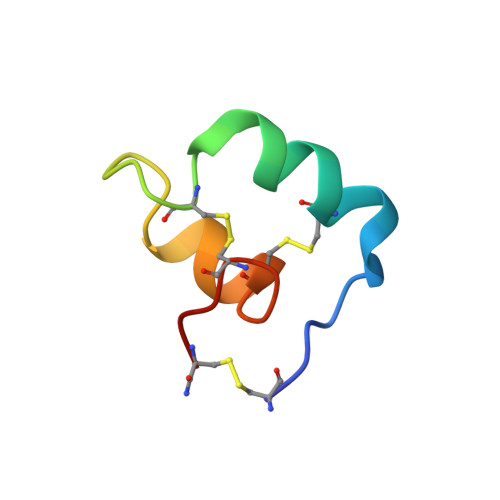Synthetic hookworm-derived peptides are potent modulators of primary human immune cell function that protect against experimental colitis in vivo.
Smallwood, T.B., Navarro, S., Cristofori-Armstrong, B., Watkins, T.S., Tungatt, K., Ryan, R.Y.M., Haigh, O.L., Lutzky, V.P., Mulvenna, J.P., Rosengren, K.J., Loukas, A., Miles, J.J., Clark, R.J.(2021) J Biol Chem 297: 100834-100834
- PubMed: 34051231
- DOI: https://doi.org/10.1016/j.jbc.2021.100834
- Primary Citation of Related Structures:
7L2G - PubMed Abstract:
The prevalence of autoimmune diseases is on the rise globally. Currently, autoimmunity presents in over 100 different forms and affects around 9% of the world's population. Current treatments available for autoimmune diseases are inadequate, expensive, and tend to focus on symptom management rather than cure. Clinical trials have shown that live helminthic therapy can decrease chronic inflammation associated with inflammatory bowel disease and other gastrointestinal autoimmune inflammatory conditions. As an alternative and better controlled approach to live infection, we have identified and characterized two peptides, Acan1 and Nak1, from the excretory/secretory component of parasitic hookworms for their therapeutic activity on experimental colitis. We synthesized Acan1 and Nak1 peptides from the Ancylostoma caninum and Necator americanus hookworms and assessed their structures and protective properties in human cell-based assays and in a mouse model of acute colitis. Acan1 and Nak1 displayed anticolitic properties via significantly reducing weight loss and colon atrophy, edema, ulceration, and necrosis in 2,4,6-trinitrobenzene sulfonic acid-exposed mice. These hookworm peptides prevented mucosal loss of goblet cells and preserved intestinal architecture. Acan1 upregulated genes responsible for the repair and restitution of ulcerated epithelium, whereas Nak1 downregulated genes responsible for epithelial cell migration and apoptotic cell signaling within the colon. These peptides were nontoxic and displayed key immunomodulatory functions in human peripheral blood mononuclear cells by suppressing CD4 + T cell proliferation and inhibiting IL-2 and TNF production. We conclude that Acan1 and Nak1 warrant further development as therapeutics for the treatment of autoimmunity, particularly gastrointestinal inflammatory conditions.
Organizational Affiliation:
Faculty of Medicine, School of Biomedical Sciences, The University of Queensland, QLD, Australia.














